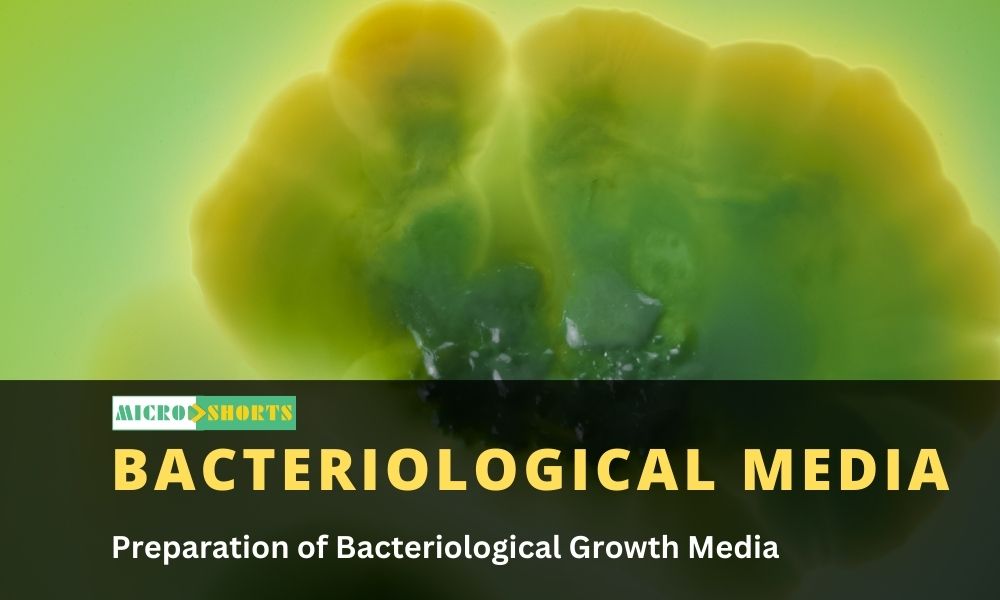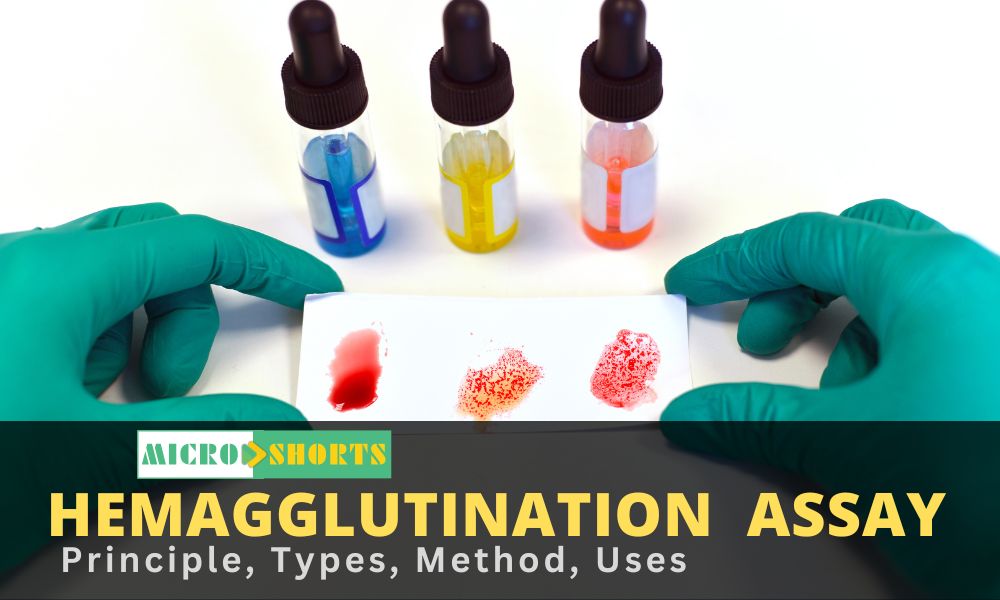Nutrient Agar
Principle
Nutrient agar allow
the growth of a variety of microorganisms that do not usually require specific
nutrients or supplements. The primary constituents are peptone, beef extract,
and agar. The peptone is the source of nitrogen or protein that acts as a
source of amino acids. The beef extract is the primary source of carbon which
is essential for the formation of carbohydrates.
It also contains
other components like some vitamins, trace minerals, organic compounds, and
salts, which enhance the growth of different organisms. sodium chloride is
added to maintain the osmotic equilibrium of the medium and prevent the change
in pH during growth. The distilled water dissolve the nutrients.
Agar is the
solidifying agent that provides a stable surface for the organism to grow on,
which allows for the observation of colony morphology and enumeration of
organism.
Procedure
Dissolve all ingredients (except sugar) by heating and adjust to pH 7.4. Add sugar powder and digest it by boiling in water bath. Recheck the pH and sterilize it by autoclaving. Nutrient broth has the same composition except that it does not contain the solidifying agent agar it is prepared in the similar manner.
MacConkey’s Agar
Principle
MacConkey Sorbitol
Agar is only slightly selective, the concentration of bile salts, which
inhibits gram-positive microorganisms. Peptone and proteose peptone supply
nutrients like nitrogenous and carbonaceous compounds, amino acids, minerals,
vitamins and trace ingredients for the growth of organisms.
Crystal violet
inhibits the growth of grampositive bacteria, especially enterococci and
staphylococci. Sodium chloride maintains osmotic equilibrium. Neutral red is an
indicator. D-Sorbitol is the fermentable carbohydrate.
Differentiation of
enteric microorganisms is achieved by the combination of sorbitol and the
neutral red indicator.The growth of E.coli O157:H7 on MacConkey agar shows
colorless colonies and most of the fecal flora ferment sorbitol and appear
pink. Colorless or pink to red colonies are produced depending upon the ability
of the isolate to ferment the carbohydrate sorbitol.
Procedure
Dissolve by heating, adjust pH to 7.4 and sterilize by autoclaving.
Eosin Methylene Blue Agar
Principle
EMB agar is a
differential medium used for the isolation of coliforms. Aniline dyes (eosin
and methylene blue) inhibit Gram-positive and fastidious Gram-negative
bacteria. Both dyes combine to form a neutral compound which precipitates at
acidic pH, thus serving as an indicator of acid production. Typical colonies of
strong lactose fermenter E.coli are small nucleate with a greenish black
metallic sheen. While atypical colonies of weak lactose fermenter En.aerogenes
appear as opaque, non-nucleated and mucoid. lactose non-fermenters produce
transparent colonies.
Procedure
Dissolve ingredients (except lactose, eosin and methylene blue) in distilled water by heat and sterilize by autoclaving. Add lactose, eosin and methylene blue after autoclaving. Mix well and steam it for 5 minutes.
Wilson & Blair’s Agar for salmonella spp.
Principle
WB agar is highly
selective medium for Salmonella. Due to the presence of brilliant green dye and
the heavy metal bismuth, most species of Gram-positive bacteria, lactose
fermenting coliforms and the shigella are completely inhibited.
As the typhoid
organism grow in presence of glucose it reduces sodium sulphite to sulphide
which together with bismuth forms bismuth sulphide. The organism in presence of
bismuth Sulphide and glucose forms black colonies provided the medium is not
too acidic. To prevent excess of acidity (due to fermentation of glucose)
sodium phosphate is present the buffer. Ferric citrate is added to neutralize
the toxicity of bismuth. Colonies of Salmonella typhi appear black, while Salmonella
paratyphi B appear black with a metallic sheen. Salmonella paratyphi A produce
greenish colonies.
Procedure
Dissolve separately
bismuth ammonium citrate & sodium sulphite, in little amount of distilled
water. Mix both solution. Add Na2HPO4 & glucose. Adjust final volume to 200
ml with distilled water.
CLED Medium
Cysteine Lactose Electrolyte Deficient Agar for Urinary Tract Infection
Principle
The CLED comprises of enzymatic digest of Casein & gelatin, and beef extract which provide the nitrogen, vitamins, mineral and amino acids essential for growth. L-cystine supports the growth of cysteine-dependent dwarf coliform colony. Lactose is the fermentable carbohydrate which provides carbon and energy. Organisms capable of fermenting lactose will lower the pH and change the color of the medium from green to yellow. The color change is indicated by the presence of pH indicator Bromothymol Blue. Agar present in the medium is the solidifying agent.
Procedure
Add component to distilled / deionized water and bring volume to 1 liter.Mix throughly . Gently heat while stirring & bring to boiling autoclave for 15 min. at 15 psi pressure and 121`C. Cool to 55`C, pour into sterile petridish or distribute into sterile tubes.
King’s Medium for Pseudomonas sp.
Principle
Pseudomonas
aeruginosa is known to produce two types of pigments pyocyanin and fluorescein.
Pyocyanin is green while fluorescein is fluorescent yellow Kings Medium B Base
is particularly suited for fluorescein. It is used for the non-selective
isolation and pigment production of Pseudomonas species.
These media contain
proteose peptone, which provides carbonaceous and nitrogenous compounds for the
growth of bacteria. Glycerol serves as a source of energy and also enhances
pigment production. Magnesium sulphate also enhances pigment production.
The production of
pigments especially nonfluorescent blue pigment, pyocyanin is readily
demonstrated by culturing on Kings Medium B. The addition of dipotassium
phosphate increases the phosphorus content of the medium thereby enhancing
production of fluorescent pigment.
Procedure
Add component to distilled water and bring volume to 1 liter. Mix thoroughly, gently heat & bring to boiling. Distribute into tubes or flask. Autoclave for 15 minute at 15 psi 121`C. Pour into sterile petridish or tubes.
Mannitol Salt Agar for Staphylococcus spp.
Principle
Mannitol Salt Agar
contains peptones and beef extract, which supply nitrogen, vitamins, minerals
and amino acids essential for growth. The 7.5% concentration of sodium chloride
results in the partial or complete inhibition of bacterial organisms.
Sodium chloride
supplies electrolytes for transport and osmotic balance. Mannitol is the
fermentable carbohydrate, fermentation leads to acid production, detected by
phenol red indicator, Coagulase positive staphylococci (e.g., Staphylococcus
aureus) produce yellow colonies and a surrounding yellow medium
while coagulase negative staphylococci produce red colonies and no color change
of the phenol red indicator.
Agar is the
solidifying agent.
Procedure
Dissolve all
ingredients into distilled water by heating, pH should be adjusted to 7.3 to
7.5. autoclave at 121°C for 15 minutes at 15 PSI pressure. Cool the medium to
50-55°C and dispense in sterile petridish.
Advantages of Bacteriological Media
Each of these bacterial culture media has specific
advantages for the isolation and identification of different types of bacteria.
Here's a brief overview of the advantages of each:
1. Nutrient Agar
It
provides a general-purpose medium suitable for the growth of most
non-fastidious bacteria. It contains all the necessary nutrients for bacterial
growth, making it suitable for primary isolation and cultivation of a wide
range of microorganisms.
2. MacConkey’s Agar
Selective and differential medium used for the isolation and differentiation of
Gram-negative bacteria, especially enteric bacilli such as Escherichia coli and
Salmonella spp. It contains crystal violet and bile salts that inhibit the
growth of Gram-positive bacteria and allow for the selection of Gram-negative
organisms. It also contains lactose and pH indicators, allowing for the
differentiation of lactose fermenters (pink colonies) from non-fermenters
(colorless colonies).
3. EMB Agar (Eosin Methylene Blue Agar)
Selective and differential medium primarily used for the isolation and
differentiation of fecal coliforms such as Escherichia coli. It contains eosin
and methylene blue dyes that inhibit the growth of Gram-positive bacteria and
allow for the selection of Gram-negative organisms. It also contains lactose
and sucrose as fermentable carbohydrates, allowing for the differentiation of
lactose fermenters (dark colonies with a green metallic sheen) from non-fermenters.
4. King’s Medium
It is
a selective and differential medium used for the isolation and differentiation
of Gram-negative bacteria, particularly Salmonella spp. It contains peptone,
lactose, bile salts, and indicators such as neutral red, which facilitate the
detection of lactose fermentation and the differentiation of Salmonella spp.
from other enteric bacteria.
5. Wilson & Blair’s Agar
This
medium is used specifically for the isolation and identification of Salmonella
spp. from clinical samples. It contains selective agents such as bile salts and
brilliant green that inhibit the growth of other bacteria and favor the growth
of Salmonella spp.
6. CLED Medium (Cysteine Lactose Electrolyte Deficient Agar)
It is
a differential medium used for the isolation and presumptive identification of
urinary tract pathogens, particularly Escherichia coli and other
lactose-fermenting bacteria. It contains lactose and indicators such as
bromothymol blue, which allow for the differentiation of lactose fermenters
(yellow colonies) from non-fermenters (colorless colonies). Additionally, it
lacks electrolytes, making it suitable for urine culture, as excessive electrolytes
in urine can inhibit bacterial growth.
7. Mannitol Salt Agar
Selective and differential medium primarily used for the isolation
and differentiation of Staphylococcus aureus from other staphylococci and
non-staphylococcal bacteria. It contains high concentrations of salt (7.5-10%),
which inhibit the growth of most bacteria except for staphylococci. It also
contains mannitol and a pH indicator, allowing for the differentiation of
mannitol fermenters (yellow colonies) from non-fermenters (pink to red
colonies).
Disadvantage of Bacteriological Media
Here are some potential disadvantages for each of the
mentioned bacterial media:
1. Nutrient Agar:
- - Not selective: It
supports the growth of a wide range of bacteria, making it difficult to isolate
specific organisms.
- - Lack of
differentiation: It does not provide any differentiation between different
types of bacteria.
2. MacConkey’s Agar:
- - Limited use: It
is primarily used for the isolation and differentiation of Gram-negative
enteric bacteria, so it may not be suitable for other types of bacteria.
- - Selective but not
differential: While it inhibits the growth of Gram-positive bacteria, it only
differentiates between lactose fermenters and non-fermenters among
Gram-negatives.
3. EMB Agar (Eosin Methylene Blue Agar):
- - Toxicity: EMB
agar contains eosin and methylene blue dyes, which can inhibit the growth of
some bacteria.
- - Overgrowth of
non-target organisms: Some non-target bacteria may still grow on EMB agar,
potentially obscuring the presence of target organisms.
4. King’s Medium:
- - Complexity:
King's medium is relatively complex and may require more preparation time and
expertise compared to simpler media.
- - Specificity: It
is designed for specific types of bacteria and may not be suitable for other
organisms.
5. Wilson & Blair’s Agar for Salmonella spp:
- - Limited
selectivity: While it is selective for Salmonella spp., it may still allow the
growth of other bacteria, potentially leading to false positives or
contamination.
- - Time-consuming:
Identifying Salmonella spp. colonies on Wilson & Blair’s agar may require
additional biochemical tests, prolonging the overall identification process.
6. CLED Medium (Cysteine Lactose Electrolyte Deficient Agar) for Urinary Tract Infection:
- - Limited
differentiation: CLED agar primarily distinguishes between lactose fermenters
and non-fermenters, which may not provide enough information for comprehensive
bacterial identification.
- - Selectivity
concerns: While it inhibits the growth of some organisms, it may not completely
prevent the growth of all contaminants, leading to potential false positives.
7. Mannitol Salt Agar:
- - Limited application: It is primarily used for the isolation and differentiation of Staphylococcus species, so it may not be suitable for other types of bacteria.
- - High salt concentration: The high concentration of salt in Mannitol Salt Agar may inhibit the growth of some organisms while allowing others to grow, potentially leading to inaccurate results.














Comments